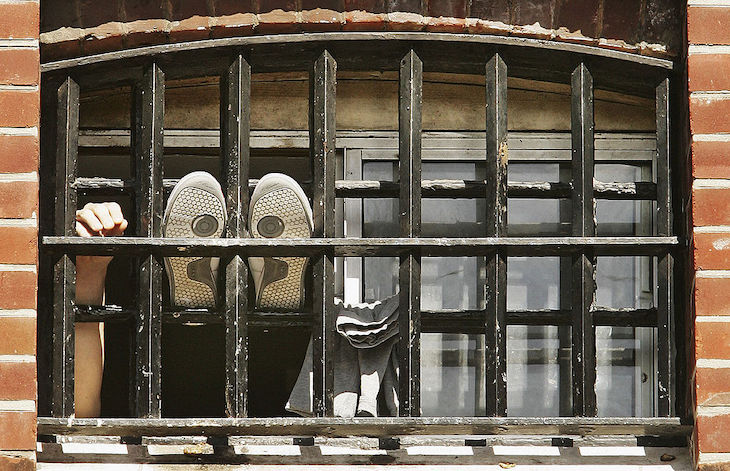It’s my seventh night in HMP Wandsworth at the start of my 45-month sentence for fraud. I live on A Wing now, with a new cellmate, John, a heroin addict. He’s an older guy, short, very slight, sores all over his face, neck and hands. Prison is full of men like John: addicts who get sentenced to a few weeks, or months, in prison. Some are regulars, welcomed back by guards and prisoners. One man completes three sentences while I am imprisoned there. What good does it do banging men like this up?
John is 52 and the best part of his life – which he has spent mostly in and out of prison – is behind him. The first of his many short sentences was in 1982, when he was just 14. In the years since, John has been in and our of prison, fighting his addiction to drugs and committing crimes.
When John is locked up, he is prescribed a drug which makes him constantly hungry. He drinks endless sweet teas, eats as much bread as he can find, and uses his prison sentences to get back to a healthy weight. He’s released. His habit starts again. And the cycle repeats itself.
The years of John’s addiction have taken their toll. I’m on the top bunk, trying to sleep. Beneath me, John’s breathing struggles out. Deep, laboured, rasping. After each breath out, there’s a long silence. Then an urgent, croaking breath in. It reminds me of my grandfather dying.
In prison, heroin is hard to get hold of. Instead, an addict’s drug of choice is often spice: a collective term for synthetic cannabinoids which are widespread in our prisons. Spice can cause breathing difficulties, seizures and psychosis. The drug is a liquid, impregnated in paper, sold in ‘sheets’ and then cut into small pieces which are smoked. This means it’s easy to smuggle into prisons, either posted or carried in. Prisons search visitors, check post and patrol to spot parcels of drugs being thrown over the walls. Mandatory Drug Tests (MDTs) are performed to catch prisoners who have been using. But the drugs keep coming.
One day, in early March 2020, an inmate collapsed during ‘S&Ds’, the daily hour during which prisoners can shower and run errands. He lay there, still, not seeming to breathe. Prisoners moved to help him but the officers ordered us all back to our cells. Locked in, but with the door flap open, we watched as officers stood around the stricken man. None moved to help him. Perhaps they weren’t trained. Perhaps they were afraid of giving CPR to an addict who might carry a disease. Eventually, over half an hour later, paramedics arrived. I heard later that the man smoked spice just before he collapsed.
I’ve thought a lot about that day. Our prisons traumatise inmates, but they do something awful to staff too. Alex South, a former prison officer, has just published Behind These Doors, a memoir of her decade working in prisons. She writes that ‘almost every officer’ develops their own kind of trauma over time. This matches what I saw in prison. New officers arrived full of empathy, enthusiasm and hopes of improving lives. Within months, they often became cynical, shutting off their empathy as a coping strategy.
When the first covid lockdown began, only prison staff were allowed in or out of Wandsworth.. With the whole country at home, it seemed certain to me that the drug supply would collapse. It didn’t. During lockdown, spice was freely traded between the wings. Tobacco, cocaine and alcohol were available, at a high price.
Even before lockdown, I heard that a prison officer could earn £1,000 for smuggling a 50g pouch of tobacco in. The rewards for smuggling drugs or phones are even higher. The average salary for a prison officer in London is less than £40,000 per year, making the temptation for some guards surely hard to resist.
Prisons spend a great deal of effort and energy searching visitors and prisoners. Cells are ‘spun’ at random or on the basis of intelligence. Post is checked. And yet our prisons still don’t always properly screen and search every employee on arrival. After I’d been released, in 2022, I worked as a consultant prison inspector, and saw how cursory staff searches can be.
The result is an environment in which prisoners can still access destructive and sometimes deadly substances. Just as it is outside, the drug trade in prisons is a cause of violence. Prisoners incur debts, and retribution is meted out when they can’t pay. Meanwhile, addicts remain addicted, and many prisoners spend their sentences asleep or in a stupor, rather than developing skills which might make them less likely to reoffend. When they are released, their drug habits start up again – and the cycle continues. What a waste of life.






Comments